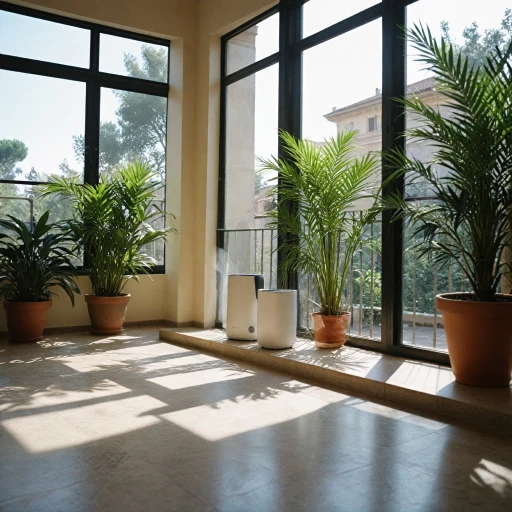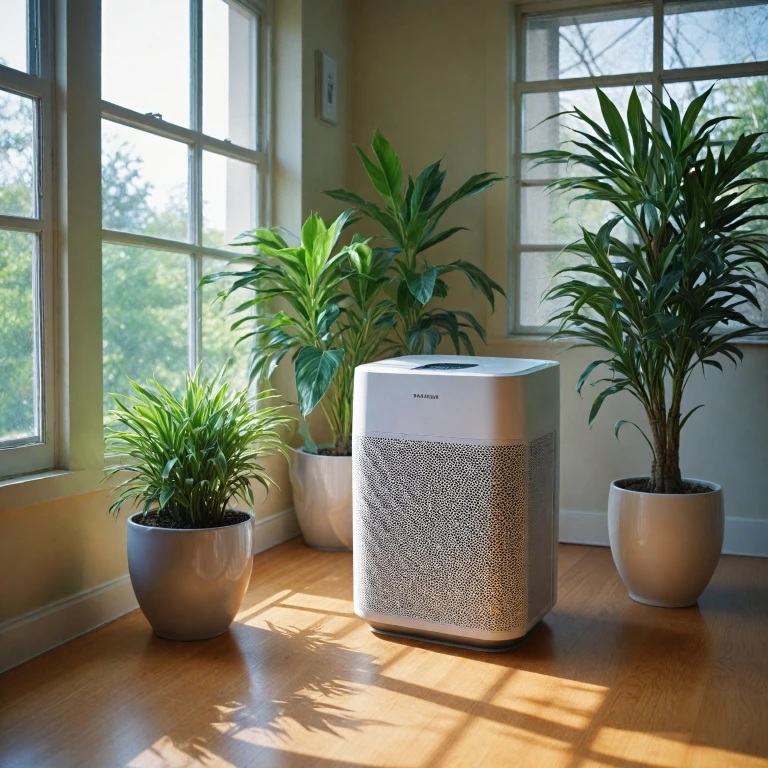Understanding Air Purifiers with Permanent Filters
Get Familiar with Permanent Filter Air Purifiers
When navigating the vast landscape of air purifiers, one type you might encounter is the air purifier with a permanent filter. Unlike standard models featuring replaceable HEPA filters or washable filters, these purifiers capitalize on a permanent filtration system. They aim to balance effective filtration with minimal maintenance costs, making them an attractive option for those conscious of price and sustainability.
Permanent filter air purifiers work by utilizing a robust filtering mechanism that is designed to last the lifetime of the product, eliminating the need for frequent filter replacements. These purifiers are often equipped with a combination of pre-filters and smart features like auto mode or quality sensors, which optimize their performance based on the air quality detected. They come in various designs, from sleek white tower models to powerful units suited for large room environments, catering to diverse preferences and needs.
The specific filters used in these purifiers can trap common air pollutants such as dust pollen, helping to maintain a cleaner indoor environment. Depending on your specific needs, whether it's improved air quality in a large space or managing everyday allergens, a purifier with a permanent filter can be a well-chosen pick. For a closer exploration into air purifiers that align with modern needs, visit
Pure Air Pro Plus for cleaner indoor air.
How Permanent Filters Work
Mechanics Behind a Long-Lasting Filtration System
Understanding how permanent filters operate in air purifiers can be crucial in making an informed choice. These filters function by following a strategic filtration process that effectively removes pollutants from the air. As air circulates through the purifier with a permanent filter, it goes through multiple stages of filtration.
Typically, air purifiers with permanent filters start with a washable pre-filter stage. This stage is essential for capturing larger particles such as dust, pollen, and pet hair. A well-designed washable pre-filter can be rinsed and reused, saving you from recurrent costs.
After the pre-filter stage, the air usually passes through a standard true HEPA filter or a HEPA-like filter, both of which are adept at capturing smaller particles, including allergens and some bacteria. The efficiency of true HEPA filters in capturing minuscule particles helps improve indoor air quality significantly.
Additionally, some smart air purifiers integrate auto mode, quality monitors, or quality sensors to adjust the filtration process according to the room’s conditions. They assess air quality continuously, optimizing the system’s performance to maintain a healthier environment.
When comparing products on platforms like Amazon or considering purifiers tested in large rooms, the advantages of having a washable component become clear. With rigorous rating and evaluation, these air cleaner units are often a top pick due to their pricing and efficiency combination. Their lifetime functionality is extended through proper filter maintenance, ensuring the air purifier continues to operate at peak performance.
For insight into the process of state-of-the-art purification systems, you might explore an
article on a similar advanced purifier model for more depth on innovative filtration methods. It offers valuable content that can also guide your choice for purifiers with washable filters.
A thorough understanding of how these filters work will empower you to assess which model suits your needs best, especially when prioritizing air quality, longevity, and cost-efficiency.
Advantages of Permanent Filters
Advantages of Choosing a Permanent Filter
When considering an air purifier, especially for your large room or space with dust pollen issues, the filter type is crucial. Opting for an air purifier with a permanent filter offers several compelling benefits over standard replaceable options.
- Cost Efficiency: Permanent filters, often paired with washable pre-filters, eliminate the need for frequent replacements. This can lead to significant savings in the long run, specifically for those who are budget-conscious or keen on sustainable living. Regular cleaning, rather than recurring purchases, effectively reduces long-term expenses.
- Environmental Impact: By reducing the disposal of used filters, opting for a purifier with a permanent and washable filter minimizes environmental waste. This makes it an environmentally friendly choice, a consideration increasingly recognized in smart, eco-conscious consumer behavior.
- Consistent Performance: Many air purifiers with permanent filters maintain consistent air quality over time due to durable materials used in their design. This ensures that air quality monitoring remains reliable, with HEPA filters maintaining their efficiency, whether capturing dust, pollen, or other airborne particles.
- Ease of Maintenance: With products available on platforms like Amazon, standard permanent filters are typically straightforward to clean. A rinse of the pre-filter or occasional wash is often all it takes. This not only enhances user convenience but maintains purifier performance, ensuring the air cleaner effectively manages your indoor air quality over time.
- Testing and Reliability: Many purifiers tested with permanent filters demonstrate high performance over time, offering enhanced air purification without the constant need to purchase new parts. This reliability often makes these purifiers a worthy pick for those prioritizing durability.
Additionally, exploring resources like those on the
benefits of charcoal filters in air purifiers can provide deeper insights into filter effectiveness in air purifiers.
Maintenance Tips for Permanent Filters
Keeping Your Permanent Filters in Top Shape
Maintaining an air purifier with a permanent filter is crucial for ensuring optimal performance and air quality. Unlike replaceable filters, permanent filters require regular attention to maintain their efficiency. Here are some tips to help you keep your air purifier running smoothly:
- Regular Cleaning: Permanent filters, including washable filters, need to be cleaned periodically. Depending on the air quality in your home and the manufacturer's recommendations, you might need to clean the filter every few weeks. This helps in removing dust, pollen, and other particles that accumulate over time.
- Use a Vacuum: For filters that are not washable, using a vacuum cleaner with a brush attachment can help remove debris. This is particularly useful for HEPA filters, which are designed to trap smaller particles.
- Wash with Care: If your air purifier has a washable filter, such as a washable pre-filter, ensure you follow the manufacturer's instructions for cleaning. Typically, this involves rinsing the filter under running water and allowing it to dry completely before reinserting it into the purifier.
- Monitor Air Quality: Some smart air purifiers come with a quality monitor or sensor that alerts you when it's time to clean the filter. Utilizing these features can help maintain the air purifier's efficiency and extend the life of the filter.
- Check for Wear and Tear: Over time, even permanent filters can show signs of wear. Regularly inspect your filter for any damage or degradation, and replace it if necessary to ensure your air purifier continues to function effectively.
By following these maintenance tips, you can ensure that your air purifier with a permanent filter continues to provide clean air for your home, making it a worthwhile investment for maintaining a healthy living environment.
Comparing Permanent and Replaceable Filters
Evaluating Permanent vs. Replaceable Filters
When you're in the market for an air cleaner, particularly an air purifier with a permanent filter or a washable filter, it's important to examine the differences between permanent and replaceable filters. To make an informed decision, consider the following aspects:
- Cost Efficiency: Permanent or washable filters come with the advantage of lower long-term costs. Unlike standard HEPA filters that require periodic replacement, these filters can be removed, washed, and reused. This considerably reduces the ongoing expense that comes with replaceable filters.
- Environmental Impact: By opting for air purifiers with washable filters, you're making a more environmentally conscious choice. Since they don’t need to be replaced as frequently as disposable filters, they contribute less waste to landfills, aligning well with sustainable practices.
- Air Quality Performance: While some users prefer true HEPA filters for their high efficiency at capturing dust pollen and other particles, many permanent filters now offer comparable performance stages. Advances in filtration technology, including smart pre filters and washable pre components, have closed the gap in efficiency.
- Maintenance Requirement: Permanent filters necessitate regular but straightforward maintenance. It’s essential to follow the manufacturer's instructions carefully to retain performance standards. Routine cleaning ensures that the air purifier continues to function optimally, improving air quality in a large room.
Whether you prioritize cost savings or environmental sustainability, selecting between permanent and replaceable filters largely depends on your personal preferences and specific needs. Remember to consider how often you'll be able to maintain the filter to ensure it stays in peak operating condition.
Choosing the Right Air Purifier for Your Needs
Finding the Ideal Air Cleaner for Your Unique Requirements
Choosing the right air purifier can be a daunting task considering the plethora of products available today, especially across platforms like Amazon. Here’s how you can narrow down your options effectively:
- Assess Room Size: Determine if you need a purifier for a large room or a smaller area. A product that boasts a true HEPA filter or large room coverage generally provides better air quality control.
- Evaluate Filtration Needs: Consider purifiers with permanent or washable filters if you're looking for long-term cost-effectiveness. Note the stage of filtration, such as washable pre-filters that capture large particles like dust pollen, followed by a HEPA or true HEPA filter for finer contaminants.
- Understand Technology & Features: Look at smart purifiers equipped with auto modes, air quality monitors, or quality sensors that adjust cleaning based on real-time air conditions. These can add convenience and efficiency.
- Budget Considerations: Weigh the price of the purifier against its features and long-term filter maintenance costs. Products with a permanent filter might have a higher upfront cost but can save money in the long run when compared to purifiers that need frequent filter replacements.
Ultimately, the key is to focus on what will address your specific concerns, whether it’s dealing with allergies from dust pollen or improving overall air quality. Don’t forget regular testing of the air quality within your space to ensure your chosen device’s efficiency and efficacy.

